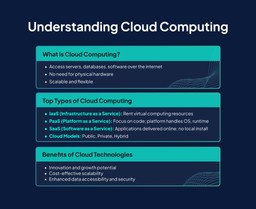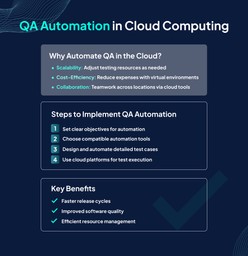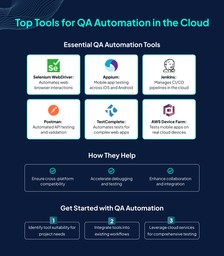Welcome to a world where awesome technology teams up with top-notch quality checks.
Today, businesses everywhere are constantly looking for cool ways to ensure their stuff works well.
And here comes cloud computing, a total rockstar in the IT world, expected to make over half a trillion U.S. dollars in revenue in 2023. With so much data in storage, quality has become ever so crucial.
Plus, imagine this: taking a QA automation course can be like unlocking a key to top-notch skills! You can learn how to automate tests and ensure all the techy stuff runs like a dream!
So why’s everyone so excited about putting cloud stuff together with quality testing?
Stick around as we delve into the world where cloud-based testing tools ensure everything runs smoothly and flawlessly.
What are Cloud Technologies?
Ever wondered how your photos, videos and important files magically appear on all your devices?
That’s the wonder of cloud technologies! Think of the cloud as a giant, invisible storage unit floating in the sky, ready to hold all your digital treasures safe and sound.
But it’s not just about storage. Cloud technologies are like the Swiss Army knives of the digital world, offering a whole toolbox of cloud services and capabilities.
From hosting websites and running applications to storing data and delivering streaming content, the benefits of cloud computing services do it all—and then some!
Cloud computing technology enables users to access computing resources such as servers, databases, and software over the Internet instead of relying on physical hardware or infrastructure.
This flexibility and scalability make the cloud a game-changer for businesses. It allows them to scale up or down as needed, pay only for what they use, and access cutting-edge technology without breaking the bank.
In the end, cloud technologies offer endless possibilities for innovation, efficiency, and growth.
Top Types of Cloud Computing
Cloud computing isn’t a one-size-fits-all solution; it’s more like a buffet with options to suit every taste and need. Here are some of the top types of cloud computing that are changing the game for businesses and individuals alike:
Infrastructure as a Service (IaaS)
Imagine having access to all the building blocks needed to create your dream digital world—without having to worry about the nitty-gritty details of hardware and infrastructure.
That’s the power of Infrastructure as a Service (IaaS). With IaaS, users can rent virtualized computing resources like storage, servers, and networking over the Internet, allowing them to build and deploy applications without investing in physical hardware.
Platform as a Service (PaaS)
Thanks to Platform as a Service (PaaS), building and deploying applications has never been easier.
With PaaS, developers can focus on writing code and building software while the cloud providers care for the infrastructure, operating system, and runtime environment.
This streamlined approach accelerates development cycles, reduces time to market, and empowers teams to innovate and iterate more quickly.
Software as a Service (SaaS)
Say goodbye to the days of buying, installing, and maintaining software on your computer. With Software as a Service (SaaS), applications are delivered over the Internet as a service, removing the need for local installation and maintenance.
From email and productivity suites to customer relationship management (CRM) and accounting software, SaaS offers a wide range of applications that can be accessed anytime, anywhere, from any device.
Public, Private, and Hybrid Clouds
Cloud computing isn’t just about where your data lives—depending on the type of cloud computing architecture, it’s also about who has access to it.
Public clouds, operated by third-party providers such as Amazon Web Services (AWS), Microsoft Azure, and Google Cloud Platform, offer shared computing resources over the Internet to multiple users.
On the other hand, a private cloud is a dedicated environment hosted either on-premises or by a third-party cloud provider.
They offer greater control, security, and customization. A hybrid cloud or “multiple cloud computing services” allows organizations to leverage the scalability and cost-effectiveness of a public cloud while maintaining sensitive data and workloads in a private environment.
How QA Interweaves with Cloud Computing
Alright, let’s talk about Quality Assurance (QA) and cloud computing—they’re like best buddies in the tech world, always there to support each other and make things run smoothly!
Here’s how QA and the cloud team up to create magic:
Scalability and Flexibility
Think of the cloud as your super-flexible friend who can adjust to any situation on the fly. When it comes to QA, this means having the freedom to scale up or down your testing resources as needed. Whether you’re running a quick test or a massive load test, the cloud has your back with its awesome scalability and flexibility.
Cost-Efficiency
Forget about those pricey hardware setups and software licenses—cloud computing is all about being budget-friendly! With the cloud, you can access virtual testing environments without breaking the bank. Say goodbye to hefty upfront costs and hello to a more cost-efficient way of doing QA.
Collaboration and Accessibility
Picture this: your QA team scattered across different locations, but still working together seamlessly. That’s the computing power of cloud-based QA tools! With the cloud, testers can collaborate from anywhere, sharing test cases and working together like a well-oiled machine.
Automation and Continuous Integration
Automation is the name of the game in QA, and the cloud is the perfect playground for it! Cloud-based testing tools make it easy to automate repetitive tasks, speed up release cycles, and improve software quality.
Plus, with continuous integration, you can keep testing on track throughout the development process.
Security and Compliance
You know that friend who’s always got your back? That’s the cloud when it comes to security! Cloud computing providers take security seriously, so you can trust that your testing environments are safe and compliant with industry regulations.
Steps into QA Automation Testing in Cloud Computing
Alright, buckle up because we’re about to embark on an exciting journey into the world of QA automation testing in cloud computing!
Here are the steps to get you started on this awesome adventure:
Set Clear Objectives
First things first, know what you want to achieve with your QA automation testing. Whether it’s speeding up testing processes, improving software quality, or reducing testing costs, having clear objectives will guide your automation efforts and keep you on track.
Scenario: Imagine you’re part of a development team tasked with launching a new e-commerce website.
Your objective is to ensure that the website’s checkout process is smooth, secure, and user-friendly. By setting clear objectives, you focus your automation efforts on testing critical functionalities like adding items to the cart, entering payment information, and processing orders.
Choose the Right Tools
With so many awesome automation tools out there, choosing the ones that best suit your needs and requirements is important. Look for tools that are compatible with cloud computing platforms, offer robust automation capabilities, and integrate seamlessly with your existing workflows.
Scenario: As you research automation tools, you discover that Selenium WebDriver and Appium are popular choices for web and mobile app testing, respectively. You choose these tools for their robust features, compatibility with cloud platforms like AWS Device Farm, and extensive community support.
Design Test Cases
Now, it’s time to roll up your sleeves and design your test cases. Start by identifying the features/ functionalities that need to be tested, then create detailed test scripts and scenarios to cover them. Be sure to include both positive and negative test cases to ensure thorough coverage.
Scenario: With your objectives in mind, you create detailed test cases for the checkout process. For positive test cases, you script scenarios where users successfully complete purchases with different payment methods.
For negative test cases, you simulate scenarios like entering invalid credit card information or encountering network errors during checkout.
Set Up Testing Environments
With cloud computing, setting up testing environments is a breeze. Take advantage of cloud-based testing services and platforms to create virtualized environments that mimic real-world scenarios.
This allows you to run tests in parallel, scale resources as needed, and access a wide range of testing configurations.
Scenario: Using a cloud-based testing platform like Sauce Labs or BrowserStack, you create virtualized testing environments replicating various devices, browsers, and operating systems.
This allows you to run tests across different configurations simultaneously, ensuring platform compatibility and consistency.
Automate Tests
Here comes the fun part—automation! Use your chosen automation tools to automate your test cases and scenarios. This involves writing scripts or using visual test automation tools to simulate user interactions, verify expected outcomes, and detect bugs or defects automatically.
Scenario: Armed with your chosen automation tools, you write scripts to automate the checkout process. Using Selenium WebDriver, you script interactions like clicking buttons, filling out forms, and verifying order confirmations.
You use Appium to automate interactions like tapping buttons, swiping screens, and verifying text fields for mobile app testing.
Execute Tests
Once your tests are automated, it’s time to put them to the test! Run your automated test suites in your cloud-based testing environments to verify that everything works as expected.
Scenario: You execute your automated test suites in your cloud-based testing environments, running tests across different devices, browsers, and platforms.
You monitor test execution in real-time, observing for any failures or issues that may arise during testing.
Analyze Results
After executing your tests, it’s important to analyze the results to identify any areas for improvement. Look for patterns or trends in test failures, gather feedback from testers and stakeholders, and use this information to refine your automation scripts and testing processes.
Scenario: After test execution, you analyze the test results to identify any defects or areas for improvement. You review test logs, screenshots, and error messages to pinpoint the root cause of failures, documenting issues and prioritizing them for resolution.
Iterate and Improve
QA automation testing is a continuous journey of learning and improvement. Take the time to iterate on your automation efforts, incorporating feedback, addressing issues, and adapting to changes in your software or testing requirements.
Scenario: Based on your analysis of test results, you iterate on your automation scripts, addressing any issues or deficiencies uncovered during testing. You collaborate with developers to fix bugs, enhance test coverage, and optimize testing processes for future releases.
By continuously improving your automation testing practices, you can achieve greater efficiency, reliability, and effectiveness in your QA efforts.
Best QA Automation Tools for Cloud Computing
Okay, let’s talk about the superheroes of QA automation tools that make testing in the cloud a breeze!
Here are some of the best tools that are rocking the world of cloud computing:
Selenium WebDriver
You’re a QA engineer testing a web application hosted in the cloud. With Selenium WebDriver, you can automate browser interactions and validate the functionality of your web application across different browsers and platforms. Whether it’s Chrome, Firefox, or Safari, Selenium WebDriver has got you covered with its automation capabilities.
Appium
Your team is developing a mobile app that will be deployed to various devices and operating systems in the cloud. Enter Appium, the go-to tool for mobile app testing. With Appium, you can automate interactions like tapping buttons, swiping screens, and verifying text fields across iOS and Android devices, ensuring a seamless user experience no matter where your app is deployed.
Jenkins
You’re responsible for setting up continuous integration and continuous delivery (CI/CD) pipelines for your cloud-based applications. Jenkins comes to the rescue with its robust automation capabilities, allowing you to automate build, test, and deployment processes in the cloud. With Jenkins, you can trigger automated tests whenever code changes are committed, ensuring rapid feedback and seamless delivery of updates to your cloud applications.
Postman
Your team is developing and testing RESTful APIs for a cloud-based application. Postman is your trusty companion for API testing, allowing you to create and execute automated API tests with ease. With Postman, you can validate API endpoints, send requests, and analyze responses, ensuring that your APIs are functioning correctly and delivering the expected results.
TestComplete
You’re working on a complex web application with dynamic elements and rich user interactions. TestComplete comes to the rescue with its comprehensive automation capabilities, allowing you to create automated tests for web applications hosted in the cloud. With TestComplete, you can record and playback test scenarios, perform data-driven testing, and validate UI elements, ensuring the quality and reliability of your web applications.
AWS Device Farm
Your team is developing a mobile app and needs to test it across a wide range of devices and platforms. AWS Device Farm is your one-stop solution for mobile app testing in the cloud.
With AWS Device Farm, you can run automated tests on real devices in the AWS cloud, ensuring compatibility and performance across iOS and Android devices without the need for physical hardware.
QA Automation Mastery with Syntax Technologies
Mastering QA automation in the cloud is essential for ensuring the quality, reliability, and scalability of your applications in today’s digital landscape.
By leveraging the power of top automation tools and cloud computing services, you can streamline testing processes, accelerate release cycles, and deliver exceptional user experiences.
At Syntax Technologies, we understand the importance of staying ahead in the ever-evolving world of QA automation.
That’s why we’re thrilled to offer a comprehensive QA automation course that covers everything you need to know to succeed.
From Java automation and programming fundamentals to the essentials of software testing, our course provides hands-on training and real-world insights to help you become a QA automation expert.
With our expert instructors and practical approach, you’ll gain the skills and knowledge you need to excel in QA automation and propel your career forward.
Enroll now and take your QA automation journey to new heights!




